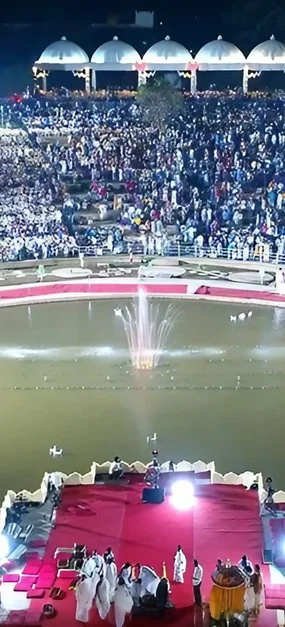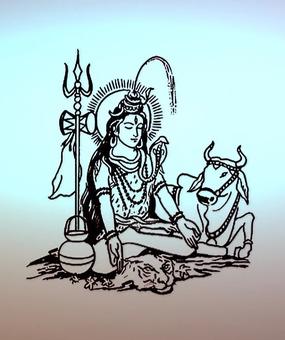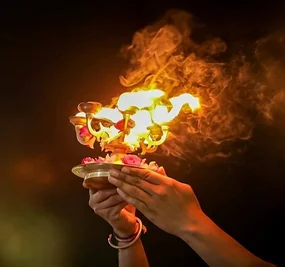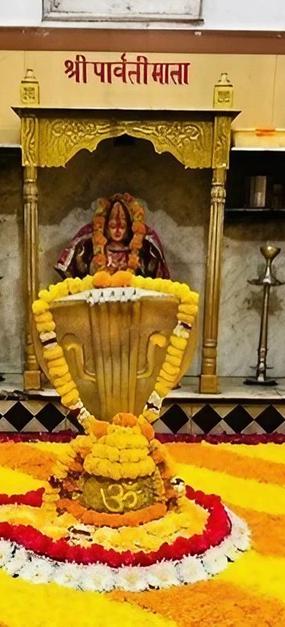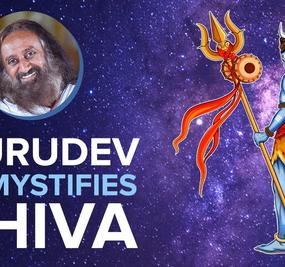All You Needed to Know and More about Lord Shiva’s Five Primary Manifestations on Earth
Lord Shiva is worshipped for many reasons all over India. However, in South India, He is worshipped as the presiding deity of the five elements of Nature, and is called Bhootapati or Bhootnath.
Na | Ma | Shi | Va | Ya – these five syllables indicate the five elements (known as Bhoota in Sanskrit) – Earth, Water, Fire, Air, and Ether. The five elements are the building blocks of everything in Creation, including the human body, and Lord Shiva is the upholder of the five elements.
There is an ancient saying in India – Without the permission of Lord Shiva, even a blade of grass couldn’t sway to the wind. Honouring this aspect of Lord Shiva (as the upholder of the five elements) are the Pancha Bhoota Sthalams – the five Shiva temples, each of which represent one of the five elements of Nature. All of these temples are located in the Southern part of India and each temple has a unique story to tell with a distinct spiritual essence.
Here is a small attempt to take you on an imaginary tour of the five temples, till you get the opportunity to visit them life size.
Earth Element | Kanchipuram, Tamil Nadu
In the Ekambareshwarar temple, Lord Shiva is represented by a Lingam made out of sand to depict the Earth element. This is also known as Prithvi Lingam. Here, Lord Shiva is fondly worshipped as Ekambaranathar and Ekambareshwar. Ekambareshwarar means Lord of the Mango Tree and there is a legend regarding the origin of the temple.
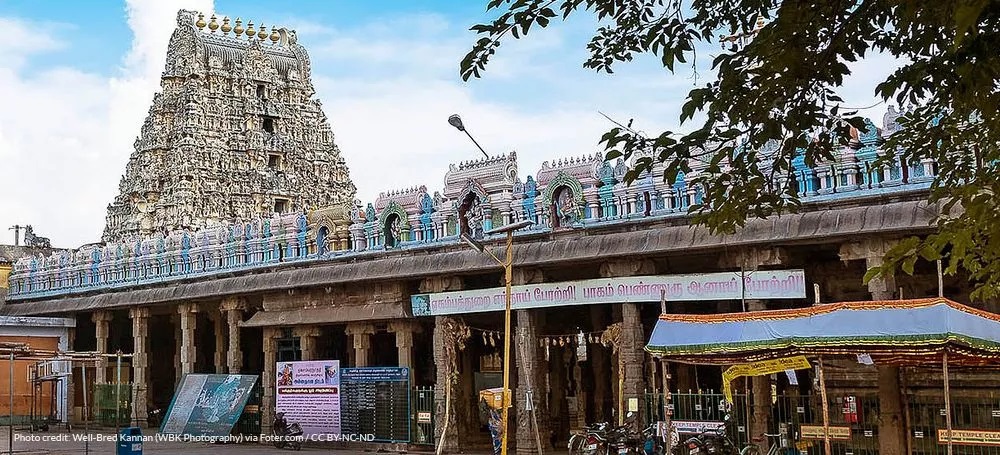
Once upon a time, Goddess Parvathi was in deep penance under a mango tree. In order to test her devotion, Lord Shiva sent the river Ganga to disrupt her penance and test her devotion. Goddess Parvathi then prayed to Ganga not to harm her as they were sisters. Ganga then did not disturb her penance. Goddess Parvathi made a Shiva Lingam from the sand near the Mango Tree in remembrance of the Lord, and consecrated it. Even today, to prevent the sand-made Shiva Lingam from deteriorating, the Abhishekam is done with jasmine oil (as it is a low-density fluid).
Essence of the Story
One does not need special idols or sculptures to enshrine God, but just a fistful of sand with all of one’s devotion.
5 Facts about the Ekambareshwarar Temple
- The temple is the tenth largest temple in India, spread over 23 acres.
- It has one of the tallest Gopurams (monumental ornate gateway tower) in South India, at 190 feet.
- Having been in existence since at least 600 AD, the Ekambareshwarar temple is one of the most ancient temples in India.
- There is a mango tree inside the temple that is said to be more than 3000 years old.
- Many kings have contributed to the architecture of the temple.
Water Element | Thiruvanaikaval, Trichy, Tamil Nadu
The Jambukeshwarar Temple in Trichy depicts the water element. Here, Lord Shiva is worshipped in the form of Appu Lingam (a water Lingam). In the shrine of the temple, a stream of water flows under the Lingam. This engulfs the Lingam with water, embodying the water element.
As the story goes, Goddess Parvathi as Akhilandeshwari found the Jambu forest to perform her penance. Here, she made a Lingam out of water and worshipped it, which is known as the Appu Lingam. Legend goes that it was then that Lord Shiva appeared to her and taught her the Shiva Gnana (the ultimate knowledge by Lord Shiva).
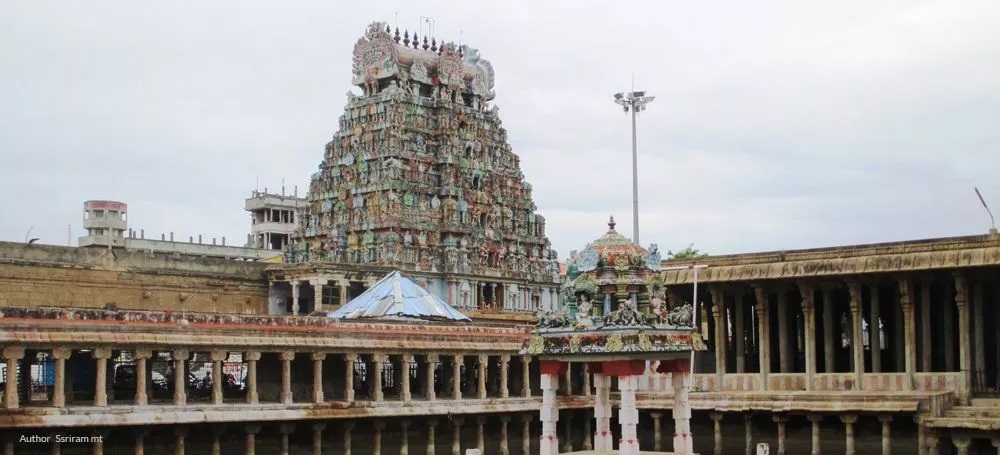
As Lord Shiva and Goddess Parvathi share a Guru and disciple relationship here, the Shivaratri celebrations of Girija Kalyanam (wedding of Lord Shiva and Goddess Parvathi), which is otherwise conducted in Shiva temples is not performed in this temple, and the idols in the temple are installed opposite each other.
It is believed that the Mother Divine (Goddess Parvathi) worshipped Lord Shiva in this temple, and so even today the priests of the temple dress up like a woman and offer prayers to the Lord as a symbolic depiction of Goddess Akhilandeshwari’s worship. This daily ritual is attended by many pilgrims every day.
Essence of the Story
Lord Shiva is worshipped as the highest teacher in the ancient Indian tradition. Water symbolises wisdom and the flow of water represents learning. The Jambukeshwarar temple therefore symbolises the significance of wisdom and learning in the most beautiful way.
It is said that those who offer worship at this temple will be bestowed with wisdom and intelligence.
5 Facts about the Jambukeshwarar Temple
- The temple is around 1800 years old and was built by Kocenganna Chola.
- It is the thirteenth largest temple in India, spread over 18 acres.
- There are inscriptions on the walls of the temple from the Chola period.
- The Uchi Kala Pooja, which is conducted every afternoon, is very famous; in this pooja, the priests dress up in a saree, representing Goddess Parvathi, and perform Abhishekam on the Appu Lingam.
- It is said that the stream of water below the Appu Lingam never dries up.
Fire Element | Annamalai Hills, Thiruvannamalai, Tamil Nadu
The Arunachaleswarar Temple depicts the Fire element bestowed by Shiva and is represented by the Agni Lingam. The Arunachaleshwarar Temple is one of the most visited and revered pilgrim centres in India.
As the story goes, once upon a time, Goddess Parvathi playfully closed the eyes of Shiva. This led to a blackout in the universe for thousands of years. Upon penance by His devotees, Shiva appeared as a column of fire on the Annamalai hill in Thiruvannamalai.
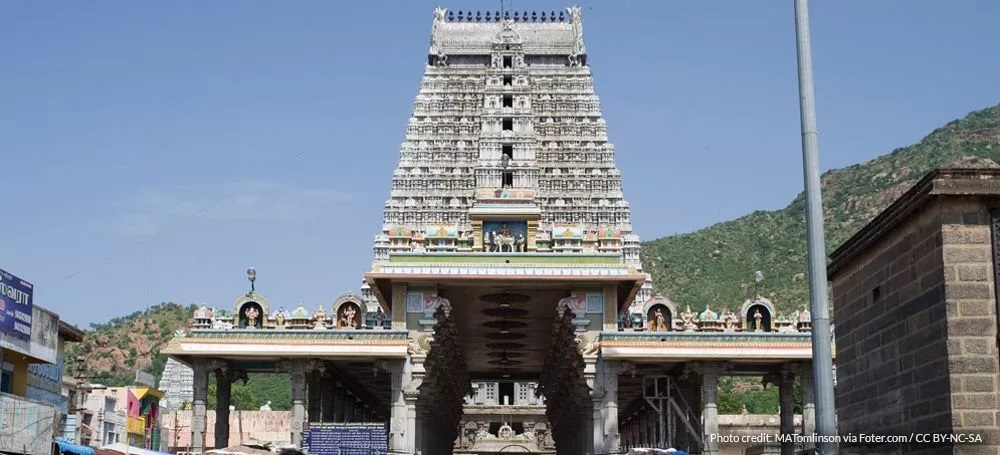
There is another story that explains the Fire element of Shiva – When Lord Vishnu and Lord Brahma contested for superiority, Shiva appeared as a flame and challenged Them to find His source. Brahma took the form of a swan and flew up towards the sky to see the top of the flame, while Vishnu became a boar and went downwards. This scene in Hindu Mythology is called lingothbava. Brahma and Vishnu failed to find the source. While Vishnu conceded His defeat, Brahma lied that He had found the pinnacle. In punishment, Shiva ordained that Brahma would never have temples on Earth in his worship.
Essence of the Story
Fire represents purity, Fire represents light, and Fire represents energy. And worshiping, chanting, and remembering the Divine brings purity into our lives, our minds, and our hearts.
The Arunachaleswarar deity is said to bless seekers with the light of knowledge, a cleansing of karmic impressions, and positive energy.
5 Facts about the Arunachaleshwarar Temple
- The largest temple in the world dedicated to the worship of Lord Shiva.
- The temple is said to be the eighth largest temple in India; it uses all its 24 acres area completely for religious purposes.
- The history of this temple dates back thousands of years and it has even been mentioned in sacred Tamil scriptures.
- Every full moon, thousands of pilgrims perform the Girivalam, which is a form of worship done by the circumambulation of the Arunachala hill. This is a 14-km long walk. The legend is that this walk washes away sins, fulfils desires, and gives one freedom from the cycle of birth and death.
- The temple has four Gopurams, one on each side. The highest of these is called Rajagopuram, which is 217 feet in height and is the third largest in India.
Air Element | Srikalahasti, Andra Pradesh
Located on the banks of the Swarnamukhi River, the Kalahastheeshwara Temple depicts the Air element. Lord Shiva is worshipped at this temple in the form of Vayu Lingam, representing the wind.
Srikalahasti is known as the Kailash of the South. Srikalahasti gets its name from Sri – a spider, Kala – a snake, and Hasti – an elephant. These creatures had pleased Shiva with their selfless devotion.
There is a lamp inside the inner sanctum that is constantly flickering despite the presence of air inside. The Vayu Lingam can be observed to move even when the priests close off the entrance to the main deity room, which does not have any windows. The Lingam is white and is considered Swayambhu, or self-manifested.
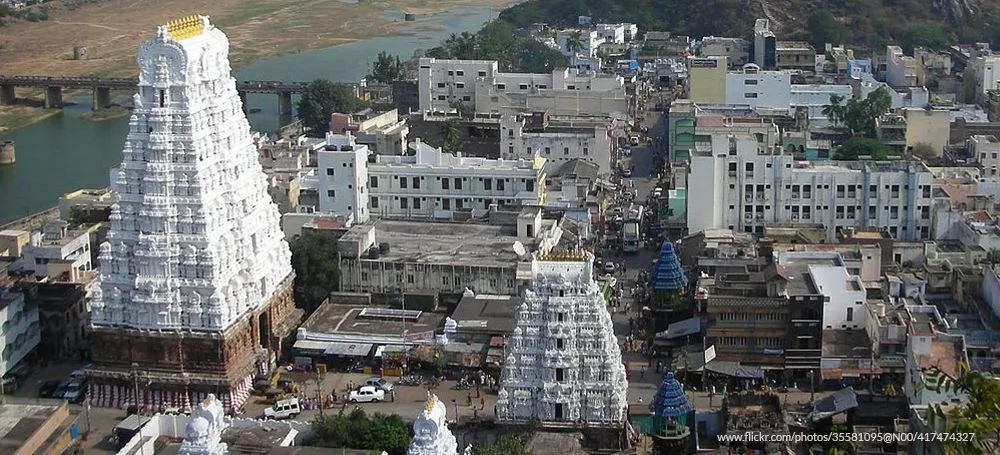
Lord Shiva is said to have manifested as a Vayu Lingam when Vayu Deva—the God of Wind—prayed for a boon to be present in all living creatures across the Universe, like the Almighty himself. Lord Shiva then manifested himself as a white Lingam, which is also called Karpoora Linga. Even today, the lingam is white in colour, adding credence to the tale.
Essence of the Story
Air represents life. Without air, there is no life on this Universe. Just as we worship the Air element, we worship the Shiva Tattva present in each and every living being on this Creation.
5 Facts about the Kalahastheeshwara Temple
- The initial structure of the temple was constructed in the 5th century. The active construction of the Srikalahasti continued for centuries after that.
- The main Gopuram is 120 feet high and was built in 1516 AD by the Vijaynagar King Krishnadevaraya. It is considered to be an architectural marvel.
- The Gopuram collapsed in May 2010 and is currently under renovation.
- The temple is famous for their Rahu-Kethu poojas. It is believed that the ill-effects manifesting due to the positioning and movements of the planets Rahu and Kethu can be warded off when this particular Pooja is performed with utmost devotion.
- It is said that the priests never touch the Vayu Lingam of the Kalahastheeshwara temple with their hands.
Ether Element | Chidambaram, Tamil Nadu
The Thillai Nataraja Temple in Chidambaram worships the Ether (Sky) element, the subtlest of the five elements. Lord Shiva is worshipped in His formless form in the Thillai Nataraja Temple.
The town of Chidambaram has a fascinating story that reveals a lot of rich information about Shiva. Lord Shiva was once strolling in the mangrove forests (Thillai Vanam) located at Chidambaram. The forest housed sages who believed in magic and that God can be controlled by rituals and mantras. The sages and their wives were enchanted by the beauty of Lord Shiva. On seeing their womenfolk enchanted, the rishis got enraged and invoked scores of serpents. Lord Shiva lifted the serpents and donned them as ornaments on his matted locks, neck, and waist.
Further enraged, the sages invoked a fierce tiger, whose skin was used by Lord Shiva as a shawl around His waist. Then followed a fierce elephant, which was devoured and ripped to death by Lord Shiva. The Rishis finally invoked Muyalakan, who symbolizes the arrogance and ignorance in all of us. Lord Shiva crushed the demon under His feet and performed theAnanda Tandava (the dance of Eternal Bliss) and disclosed His real form. The idol of Nataraja in Chidambaram depicts the deity performing theAnanda Tandava.
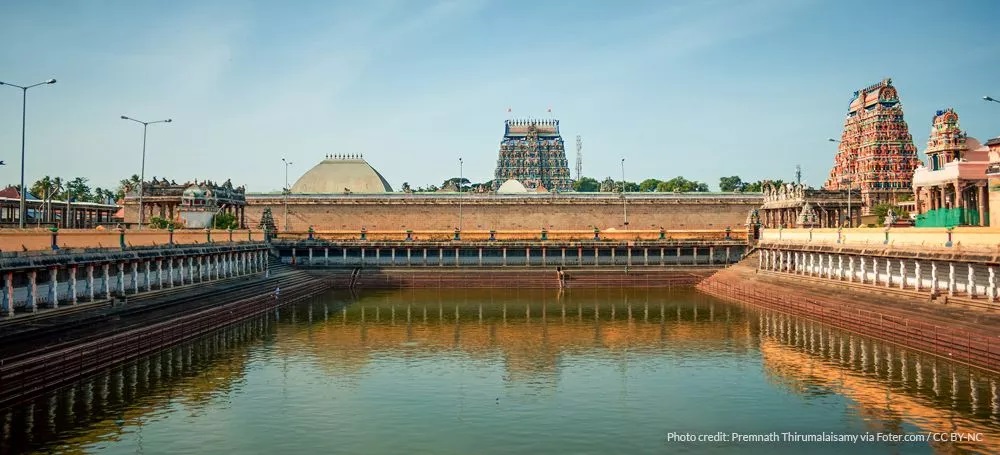
Apart from Nataraja, the Chidambara Rahasya, or the greatest secret, is said to have originated from this temple. The Chidambara Rahasya depicts the priest unveiling the curtain to an empty space within the inner sanctum of the temple. This symbolises the removal of the curtain of ignorance to attain the Ultimate Bliss. The Chidambara Rahasya is hence a representative of that time when one, in total surrender, allows God to intervene and remove our ignorance, even as we get to see and experience His presence and hence experience Deep Bliss.
Essence of the story
The goal of spiritual practices is to attain Bliss. The motive of the path is to make you hollow and empty. Thillai Nataraja symbolizes the path spiritual seekers need to take to attain the ultimate divinity.
Thillai Nataraja therefore symbolizes that the ultimate motive of a seeker is to achieve emptiness.
5 Facts about the Thillai Nataraja Temple
- The temple is the fifth largest temple in India, expanding over a space of 40 acres, located in the heart of the town of Chidambaram.
- The word “Chidambaram” is derived from the word “Chit”, which means consciousness, and “Ambaram”, which means the sky. It refers to the “Sky of Consciousness”, which is the ultimate aim of human life.
- It is the only temple out of the Panch Bhoota Sthalam where Lord Shiva is represented by an anthropomorphic idol rather than the Lingam. The temple also worships Lord Shiva in the form of a Lingam made out of crystal and in his formless form (represented by an empty room).
- The Gopuram of the temple carries a gold-plated roof by the Chola King Parantaka.
- Legend has it that the temple is located at the lotus heart of the universe – Virat hridaya padma sthalam.



